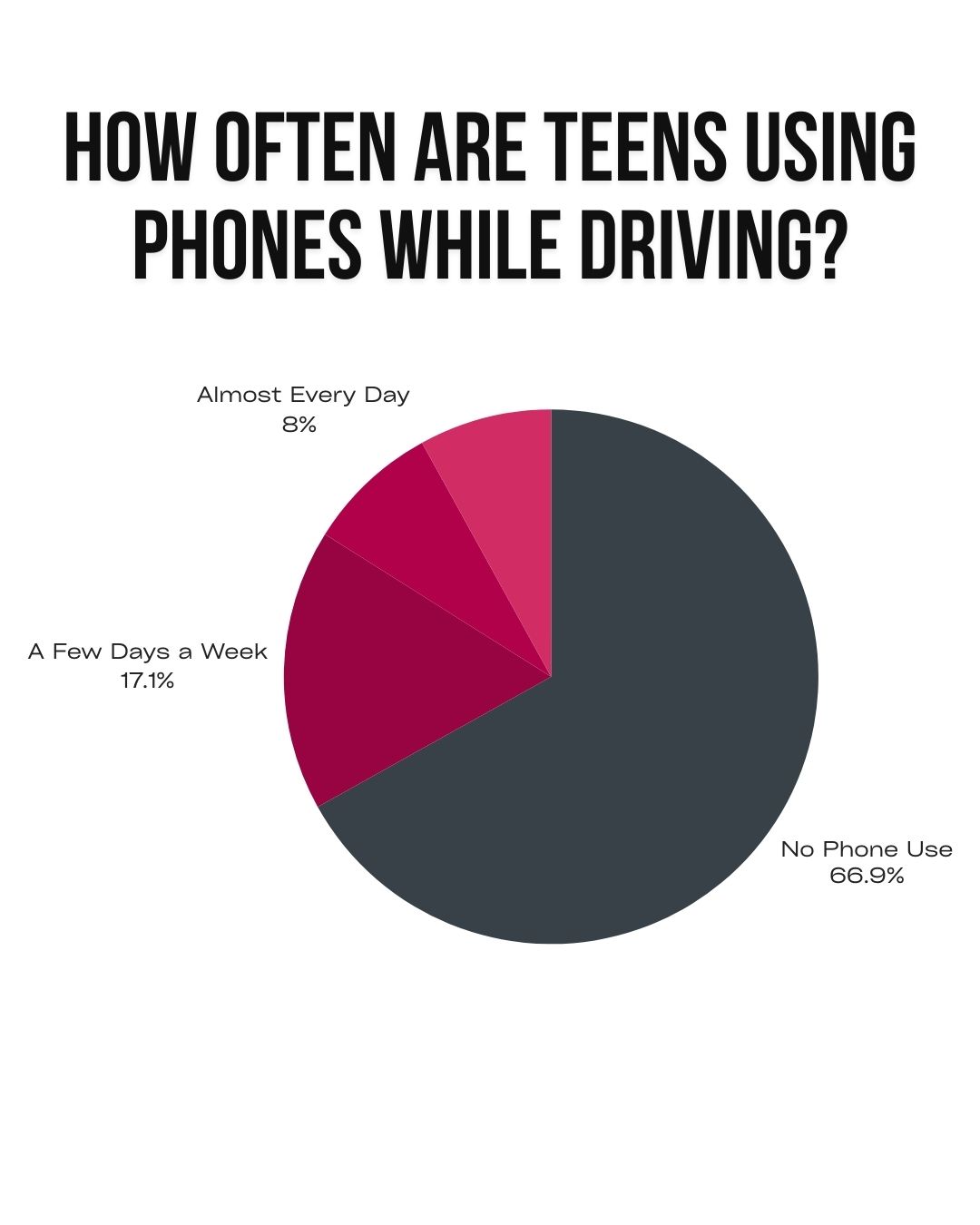Cell phone use while driving is one of the biggest threats on the road today. Despite that fact, texting and other kinds of phone use remain distressingly common among younger drivers.
APRIL 29, 2025 — A new study conducted by the Traffic Injury Research Foundation USA, Inc. (TIRF USA) offers some alarming insights into the behaviors of young drivers. But on a positive note, also insights on what approaches might be most effective in reducing teen distracted driving. The study polled more than 1,200 drivers between the ages of 14 and 20, and the results may shape the future of driver education.
Young Drivers and Phone Use While Driving: Key Data
Here is a look at some of the highlights from the study:
- About 50% of respondents were confident or very confident in their ability to drive safely while using a phone
- Common reasons for that confidence included driving skill and experience, lack of past accidents, and looking away from the road for only a few seconds
- The number-one reason for phone use while driving was the belief that a parent would be upset if the driver did not answer a call
- Most respondents stated that parents and friends were the two biggest influences on their behavior while driving
Given the fact that drivers aged 16–19 are statistically the most likely to be involved in a crash, this data may be helpful to schools, parents, and anyone with an interest in public safety.

Smartphone Use While Driving
Teen drivers are often associated with phone use behind the wheel. However, texting while driving may not be quite as common as many believe — about two-thirds of respondents said they had not used a phone while driving in the past 30 days. Of the teens who reported phone use while driving, the frequency breakdown was as follows:
- About 50% reported texting while driving at least a few days a week
- About 25% reported doing so every day or almost every day
Notably, texting was not the only reported activity. Survey respondents reported using navigation apps, accessing social media, taking selfies, and even watching video content while driving.
How Do Teens Perceive Risk Behind the Wheel?
The results of the study suggest that teens may be more aware of the danger associated with texting and driving than many give them credit for. Respondents were asked to list the three most dangerous types of distracted driving. The leading responses were as follows:
- Texting
- Using social media
- Taking selfies
While survey respondents generally perceived that grooming, eating, and reaching for objects on the floor of the car were dangerous, they did not seem to associate using hands-free or Bluetooth devices with potentially dangerous cognitive distraction.
Why Do Young Drivers Use Their Phones While Driving?
Among the most concerning data in the study was respondents’ confidence in their ability to drive safely while using a smartphone:
- 15% reported feeling very confident
- 47% reported feeling confident
- 29% said they were not confident
The survey asked a particularly important question of respondents who felt confident using their phones: Why did they feel so confident? Here is how they answered:
- 49% said they were situationally aware and knew how to safely use phones
- 22% said they were experienced and competent drivers
- 16% said they were skilled multitaskers
Some dangerous phone use could be attributed to youthful hubris. However, the study also suggests that younger drivers’ behavior behind the wheel is at least partially learned. When asked to name the two biggest influences on their driving, respondents primarily mentioned parents (46%) and friends (24%).
Parents have an opportunity to model safe driving, but concerningly, some younger drivers may be learning dangerous behavior from their parents:
- 54% of respondents said their parents used the phone while driving at least sometimes
- 35% reported their parents used the phone while driving always/almost always or at least half the time
The study also asked drivers about their friends’ phone use:
- 42% indicated that their friends used the phone while driving at least sometimes
- 32% indicated that their friends used the phone while driving always/almost always or at least half the time
This portion of the study is likely to be surprising to many. Despite the fact that many people attribute younger drivers’ dangerous behaviors to peer pressure, study data suggest that teens see their parents use phones while driving more often than they see their friends do so.
Why the Study Matters?
State and national organizations are working to reduce distracted driving through education. To ensure that their efforts are as effective as possible, these organizations need to know all they can about distracted driving — not just how often it happens, but why.
Phone use behind the wheel is not unique to younger drivers. However, younger drivers are easier to reach through both school-based educational programs and parental influence.
“This survey provides all of us who work to keep teens safe from distracted driving with great information to refine our messages,” says Joel Feldman, co-founder of EndDD.org.
“Parents and teens must work together to come up with a plan so teens do not feel compelled to respond when parents call or text them when they are driving. And every teen presentation must teach teens how to effectively speak up when others drive distracted. Thank you to the Traffic Injury Research Foundation and the U.S. National Distracted Driving Coalition.”
You can download the survey in its entirety at the following link: https://bit.ly/NDDC-Youth-Survey
About the Traffic Injury Research Foundation USA, Inc. (TIRF USA)
TIRF USA is an independent, non-profit institute for road safety research. It conducts original research, provides educational tools, and develops programs to reduce distracted driving through education. Learn more at www.tirf.us.
About EndDD.org (End Distracted Driving)
EndDD.org is an awareness and education campaign created by the Casey Feldman Foundation. It sends speakers to schools and businesses around the country and aims to reduce the incidence of distracted driving crashes.
EndDD.org works in partnership with the National Highway Traffic Safety Administration (NHTSA), the Insurance Institute for Highway Safety (IIHS), and other national safety organizations.
EndDD.org and the Casey Feldman Foundation were established by Joel Feldman and Dianne Anderson after their 21-year-old daughter, Casey, was struck and killed by a distracted driver. Visit https://www.enddd.org/ to learn more.



